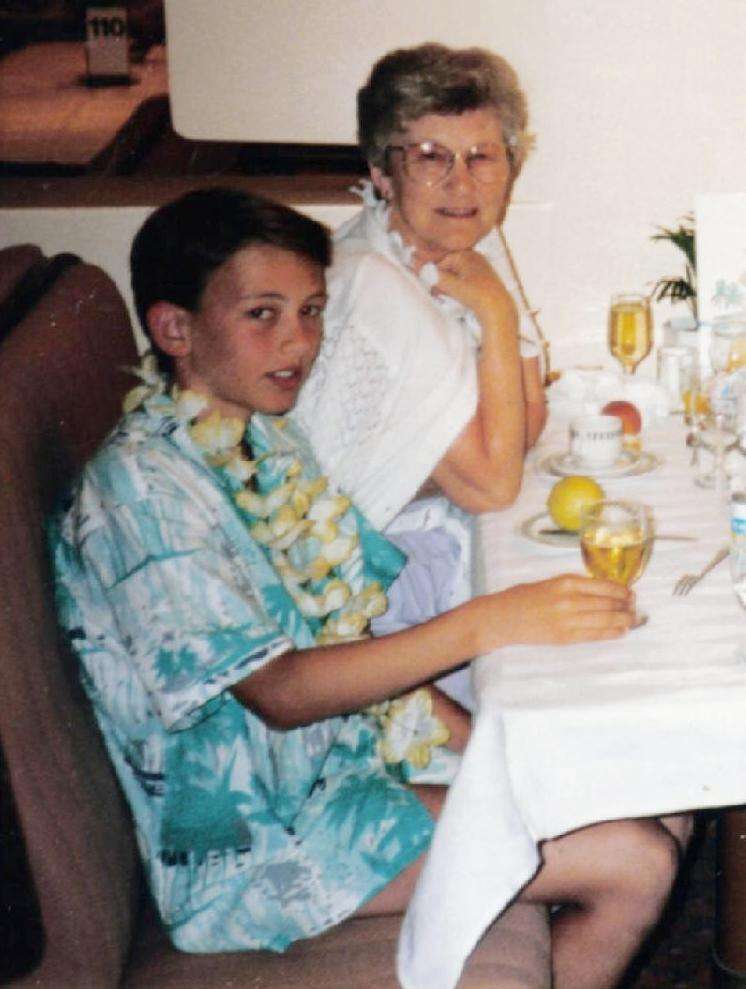
International Steamer Lines: Peninsular and Oriental Steam Navigation Company (P&O Lines)

Figure 1.--A British reader tells us, "Here is a photograph taken on board P&O liner "Camberra" (July 1988). Many British grandparents take their grand children on once in a life time treats. On this occasion the young 12 year old had been treated to a Camberra cruise to the Azores and Portugal. I came across this family the second day into the cruise. It was stormy weather and we were the only ones who were not sea sick. The ship had a special programme for children. The activities lasted all morning and on occason a coach trip to a special child centred place when ashore. This might be to a water park. The programme was very fun packed alot of games and activities related to the age of the chld. On this cruise I came across a little boy who had gotten lost so returned him to the children's club to be reunited with his parents."
|
|
The Peninsular and Oriental Steam Navigation Company was popularly known as the P&O Line. It was a British shipping and logistics company which dates to the period just after the Napoleonic Wars. Its beginnings were modest. Brodie McGhie Willcox, a London ship broker, and Arthur Anderson, an experienced Shetland Isles sailor formed a partnership to operate a shipping line (1822). At the time, shipping was still based on sail. The first routes were primarily rotes from England to Spain and Portugal. Dublin shipowner, Captain Richard Bourne, joined the original two partners (1835). With the new partner, the company was able to begin regular service between London and Spain and Portugal. It is at tghis time the Company's name was adopted--Peninsular Steam Navigation Company (1837). Services were offered to Vigo, Oporto, Lisbon and Cádiz. The company flag colors were chosen from the colors of the Portuguese and Spanish flags at the time. The British Admiralty awarded P&O a contract to deliver mail to the Iberian Peninsula on their existing runs (1837). The Company can claim to have operated the first pasenger pleasure cruise (1840). The company won an even more important mail contract, this time to Alexandria, Egypt (1840). Egypt was not yet a British protectorate, but in the period before the construction of the Suez Canal, it was a major connection with India. was incorporated in the same year. William Fane De Salis joined the Company (1849). These mail contracts were extremely important to the company's success. The Company became one of Britain's major steamer line, offering both cargo shipping and passenger services. P&O did not compete in the Trans-Atlantic trade, but rather focused on trade with India and the Far East including Australia. The opening of the Suze Canal (1869) substantially deccreased sailing times. The Company took over the British India Steam Navigation Company (1914). The British India line was at the time Britain's largest shipping line with 131 steamers. The Germans sank 85 P&O ships during the War. The company at the end of World War I further expanded acquiring a controlling interest in the Orient Line, which had been its partner in the England- Australia mail route (1918). The company also made some smaller acquisitions. P&O was operating nearly 500 ships in the inter-War period. Another 170 P&O ships were sunk in Wotld War II, mostly by the Germans. After the War, the P&O trade with India began to decline as a result of Indian independence, but increased with Australia. A major factor here was the paid-passages promoted by the Australian Government for European immigrants. They became known as Ten Pound Poms. P&O built 15 large passenger liners, primarily forthe Australian runs. The first was SS Chusan and the last SS Canberra (1961). The ships carried many of the 1 million immigrants to Australia that arrived after the War unti; the Australian Government terminated the program (1945-68). With the advent of inexpensive air fares, the maritime passenger marget collapsed. P&O scrapped its older liners and converted the newer ones to cruise ships. The focus of the company became cargo trade. It expanded into the tanker trade (1959) and the roll-on roll-off (RORO) ferry business (1960s). P&O's cruises were run in association with Carnival Cruises. P&O was purchases by Dubai Ports, making it a subsidiary of DP World (2006).
HBC

Navigate the Boys' Historical Clothing Web Site:
[Return to the Main Steamer Lines page]
[Return to the Main Industrial Revolution page]
[Introduction]
[Activities]
[Biographies]
[Chronology]
[Clothing styles]
[Countries]
[Bibliographies]
[Contributions]
[FAQs]
[Glossaries]
[Images]
[Links]
[Registration]
[Tools]
[Boys' Clothing Home]
Created: 5:32 PM 10/10/2009
Last updated: 5:32 PM 10/10/2009



